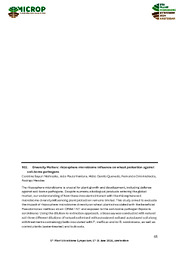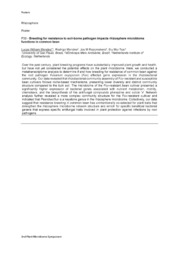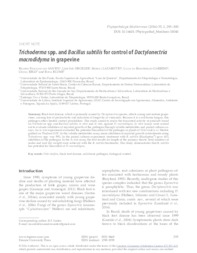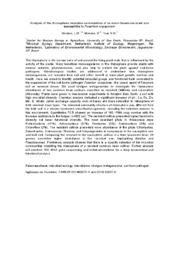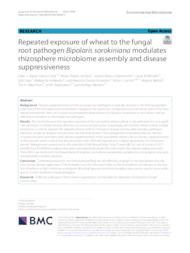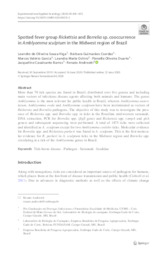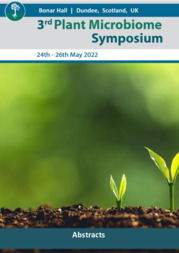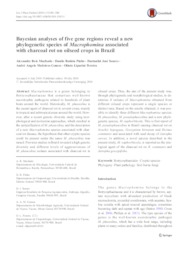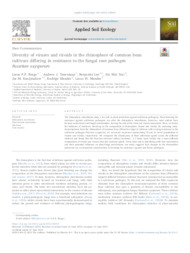Search Publications
Filter by:
| Diversity matters: rhizosphere microbiome influence on wheat protection against soil-borne pathogens Author(s): NISHISAKA, C. S.; VENTURA, J. P.; QUEVEDO, H. D.; ANDREOTE, F. D.; MENDES, R. The rhizosphere microbiome is crucial for plant growth and development, including defense against soil-borne pathogens. Despitenumerous biological products entering the global market, our understandin... ... |
| Author(s): MENDES, L. W.; MENDES, R.; RAAIJMAKERS, J. M.; TSAI, S. M. Over the past century, plant breeding programs have substantially improved plant growth and health, but have not yet considered the potential effects on the plant microbiome. Here, we conducted a meta... ... |
| Author(s): SANTOS. R. F. dos; HECKLER, L. I.; LAZAROTTO, M.; GARRIDO, L. da R.; REGO, C.; BLUME, E. Black foot disease, which is primarily caused by Dactylonectria species, affects young and mature grapevines, causing loss of productivity and reduction of longevity of vineyards. Because it is a soil... ... |
| Author(s): MENDES, L. W.; MENDES, R.; TSAI, S. M. The rhizosphere is the narrow zone of soil around the living plant roots that is influenced by the activity of the plants. Many beneficial microorganisms in the rhizosphere provide plants with mineral... ... |
| Author(s): PINTO, Z. V.; MORANDI, M. A. B.; BETTIOL, W. Abstract: The effectiveness of composted sewage sludge incorporated into Pinus bark-based substrate with or without biofertilizer, fish hydrolyzate, chitosan and Trichoderma asperellum was evaluated f... ... |
| Author(s): COSTA, L. S. A. S.; FARIA, M. R. de; CHIARAMONTE, J. B.; MENDES, L. W.; SEPO, E.; HOLLANDER, M. de; FERNANDES, J. M. C.; CARRIÓN, V. J.; BETTIOL, W.; MAUCHLINE, T. H.; RAAIJMAKERS, J. M.; MENDES, R. Abstract: Background -Disease suppressiveness of soils to fungal root pathogens is typically induced in the field by repeated infections of the host plant and concomitant changes in the taxonomic comp... ... |
| Author(s): HIGA, L. de O. S.; CSORDAS, B. G.; GARCIA, M. V.; OSHIRO, L. M.; DUARTE, P. O.; BARROS, J. C.; ANDREOTTI, R. More than 70 tick species are found in Brazil, distributed over five genera and including main vectors of infectious disease agents affecting both animals and humans. The genus Amblyomma is the most r... ... |
| Author(s): NISHISAKA, C. S.; QUEVEDO, H. D.; MENDES, R. The rhizosphere microbiome plays a significant role in the host plant?s health, such as defense against soil-borne diseases. However, the understanding of how the rhizosphere soil microbiome diversity... ... |
| Author(s): MACHADO, A. R.; PINHO, D. B.; SOARES, D. J.; GOMES, A. A. M.; PEREIRA, O. L. Macrophomina is a genus belonging to Botryosphaeriaceae that comprises well-known necrotrophic pathogens related to hundreds of plant hosts around the world. Historically, M. phaseolina is the causal... ... |
| Author(s): BRAGA, L. P.; TANENTZAP, A. J.; LEE, B.; TSAI, S. M.; RAAIJMAKERS, J. M.; MENDES, R.; MENDES, L. W. Abstract: The rhizosphere microbiome plays a key role in plant protection against soil-borne pathogens. Plant breeding for resistance against soil-borne pathogens can alter the rhizosphere microbiome.... ... |
Observation
Some of Embrapa's publications are published as ePub files. To read them, use or download one of the following free software options to your computer or mobile device. Android: Google Play Books; IOS: iBooks; Windows and Linux: Calibre.
Access other publications
Access the Agricultural Research Database (BDPA) to consult Embrapa's full library collection and records.
Visit Embrapa Bookstore to purchase books and other publications sold by Embrapa.

